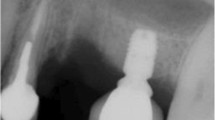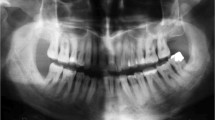Abstract
Objectives
Initial implant stability is one of the fundamental criteria for obtaining osseointegration. The aim of this study was to establish a correlation between the primary stability of short and normal implants placed in different types of bone density.
Methods
A total of 60 Nobel Biocare implants (Göteborg, Sweden®) of different length and design were inserted in 7 maxillae and mandibles of recently deceased persons (20 Replace Select® Straight 10 ´ 4.3 mm, 20 Replace Select® Tapered RP 10 ´ 4.3 mm and 20 Nobelspeedy Shorty® RP 7 ´ 4 mm). Histomorphometry was carried out to analyze the different local bone volume and the bone-to-implant contact (BIC).
Results
The mean BIC for the three implant types varied strongly in the maxilla (Replace Select® Straight 0.78% ± 1.0; Replace Select® Tapered 1.3% ± 1.2; Nobelspeedy Shorty® RP 2.35% ± 1.7) but was very similar in the mandible. A comparable pattern was found for the amount of bone tissue present within distances of 0.2 mm and 1.0 mm around the implant. All measured parameters were numerically higher in the mandible than in the maxilla.
Conclusions
The fact that shorter implants showed numerically higher values of BIC and BV/TV in the upper jaw, suggests that they may improve implant therapy in cases of poor bone supply in this region. The lack of such differences makes the existence of a similar effect less likely in the lower jaw.



Similar content being viewed by others
References
Glauser R, Portmann M, Ruhstaller P, Lundgren AK, Hämmerle C, Gottlow J. Stability measurements of immediately loaded machined and oxidized implants in the posterior maxilla: a comparative clinical study using resonance frequency analysis. Appl Osseontegr Res. 2001;2:27–9.
Da Cunha HA, Francischone CE, Filho DE, Oliveira RC. A comparison between cutting torque and RF in the assement of primary stability and final torque capicity of standard and TiUnite single-tooth implants under immediate loading. Int J Oral Maxillofac Implant. 2004;19:578–85.
Meredith N, Shagaldi F, Alleyne D, Sennerby L, Cawley P. The application of resonance frequency measurements to study the stability of titanium implants during healing in the rabbit tibia. Clin Oral Implants Res. 1997;8(3):234–43.
Sennerby L, Meredith N. Resonance frequency analysis: measuring implant stability and osseointegration. Compend Contin Educ Dent. 1998;19:493–8.
Meredith N, Friberg B, Sennerby L, Aparicio C. Relationship between contact time measurements and PTV values when using the Periotest to measure implant stability. Int J Prosthodont. 1998;11:269–75.
Renouard F, Nisand D. Impact of implant length and diameter on survival rates. Clin Oral Implants Res. 2006;17(2):35–51.
Bahat O. Treatment planning and placement of implants in the posterior maxillae: report of 732 consecutive Nobelpharma implants. Int J Oral Maxillofac Implants. 1993;8:151–61.
Renouard F, Nisand D. Short implants in the severely resorbed maxilla: a 2-year retrospective clinical study. Clin Implant Dent Relat Res. 2005;7(1):104–10.
Stellingsma C, Meijer HJ, Raghoeber GM. Use of short endosseous implants and an overdenture in the extremely resorbed mandible: a five-year retrospective study. J Oral Maxillofac Surg. 2000;58:382–7.
Bruggenkate T, Asikainen P, Foitzik C, Krekeler G, Sutter F. Short (6-mm) nonsubmerged dental implants: results of a multicenter clinical trial of 1–7 years. Int J Oral Maxillofac Implants. 1998;13(6):791–8.
Jaffin R, Berman C. The excessive loss of Brånemark fixtures in type IV bone: a 5-year analysis. J Periodontol. 1991;62(1):2–4.
Jemt T, Lekholm U. Implant treatment in edentulous maxillae: a 5-year follow-up report on patients with different degrees of jaw resorption. Int J Oral Maxillofac Implants. 1995;10:303–11.
Esposito M, Hirsch, JM, Lekholm U, Thomsen P. Biological factors contributing to failures of osseointegrated oral implants. (I) Success criteria and epidemiology. Eur J Oral Sci. 1998;106:527–51.
Gedrange T, Hietschold V, Mai R, Wolf P, Nicklsh M, Harzer W. An evaluation of resonance frequency analyses for the determination of the primary stability of orthodontic palal implants. A study in human cadavers. Clin Oral Implants Res. 2005;16:425–31.
Friberg B, Sennerby L, Roos J, Lekholm U. Identification of bone quality in conjunction with insertion of titanium implants. A pilot study in jaw autopsy specimens. Clin Oral Implants Res. 1995;6:213–9.
Norton MR, Gamble C. Bone classification: an objective scale of bone density using the computerized tomography scan. Clin Oral Implants Res. 2001;12:79–84.
Lekholm U, Zarb GA. Patient selection and preparation. In: Branemark PI, Zarb GA, Albrektsson T, editors. Tissue-integrated prostheses: osseointegration in clinical dentistry. 1st edn. Chicago: Quintessence. 1985. p. 199–209.
Gahleitner A, Hofschneider U, Tepper G, Pretterklieber M, Schick S, Zauza K, et al. Lingual vascular canals of the mandible: evaluation with dental CT. Radiology. 2001;220:186–9.
Donath K. Die Trenn-Dünnschliff-Technik zur Herstellung histologischer Präparate von nicht schneidbaren Geweben und Materialien. Der Präparator. 1988;34:197–206.
SAS. SAS/STAT User’s Guide. Version 8. Cary: SAS Institute; 1999.
Rabel A, Köhler SG, Schmidt-Westhausen AM. Clinical study on the primary stability of two dental implant systems with resonance frequency analysis. Clin Oral Investig. 2007;11(3):257–65.
Martinez H, Davarpanah M, Missika P, Celletti R, Lazzara R. Optimal implant stabilization in low density bone. Clin Oral Implants Res. 2001;12:423–32.
Orsini E, Salgarello S, Bubalo M, Lazic Z, Trire A, Martini D, et al. Histomorphometric evaluation of implant design as a key factor in peri-implant bone response: a preliminary study in a dog model. Minerva Stomotol. 2009;58(6):263–75.
Boronat-Lopez A, Penarrocha-Diago M, Martinez-Cortissoz, O. Resonance frequency analysis after the placement of 133 dental implants. Med Oral Patol Oral Cir Bucal. 2006;II:E272–6.
Nkenke E, Michael H, Konstanze W, Martin R, Friedrich W, Klaus E. Implant stability and histomorphometry: a correlation study in human cadavers using stepped cylinder implants. Clin Oral Implants Res. 2003;14:601–9.
Roze J, Babu St, Saffarzdeh A, Gayet-Delacroix M, Hoonaert A, Layrolle P. Correlating implant stability to bone structure. Clin Oral Implants Res. 2009;10:1140–5.
Buser D, Mericske-Stern R, Bernard JP, Behneke A, Behneke N, Hirt HP, et al. Long-term evaluation of non-submerged ITI implants. Part 1: 8-year life table analysis of a prospective multi-center study with 2359 implants. Clin Oral Implants Res. 1997;8:161–72.
Fugazzotto PA, Beagle JR, Ganeles J, Jaffin R, Vlassis J, Kumar A. Success and failure rates of 9 mm or shorter implants in the replacement of missing maxillary molars when restored with individual crowns: preliminary results 0–84 months in function. A retrospective study. J Periodontol. 2004;75:327–32.
Conflict of intererst
The authors declare that there is no conflict of interest.
Author information
Authors and Affiliations
Corresponding author
Rights and permissions
About this article
Cite this article
Monov, G., Vasak, C., Gahleitner, A. et al. A histomorphometric study of short and normal implants in human cadavers. J. Stomat. Occ. Med. 6, 151–156 (2013). https://doi.org/10.1007/s12548-012-0036-9
Received:
Accepted:
Published:
Issue Date:
DOI: https://doi.org/10.1007/s12548-012-0036-9




